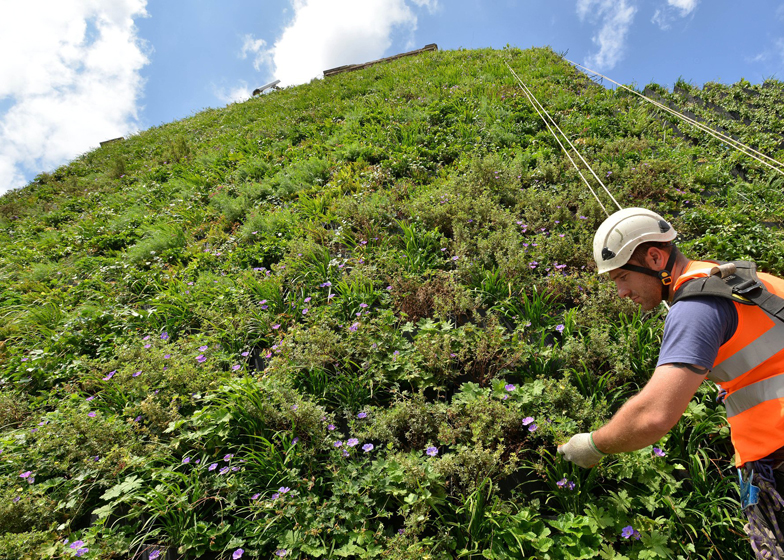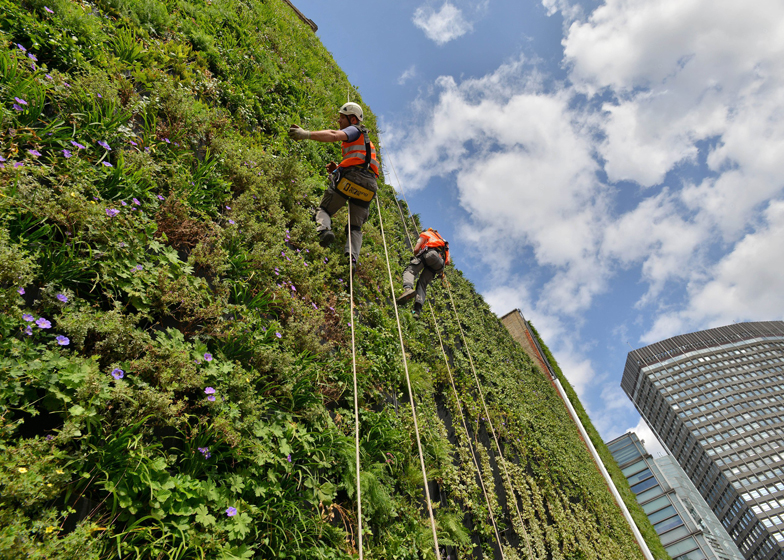News: a 21 metre high living wall containing 10,000 plants and 16 tons of soil will help reduce flooding in London, according to its designer.
The huge green wall, designed by Gary Grant of Green Roof Consultancy and covering an entire facade of a hotel, covers 350 square metres - making it the largest wall of vertical plants in London.
The permanent feature is located on the exterior wall of the Rubens at the Palace hotel in Victoria. It is made from a range of different plants that are all recommended by The Royal Horticultural Society as the best pollinators to attract wildlife such as bees, butterflies and birds to the urban environment.
The wall, which was unveiled this week, has been designed in an attempt to reduce local environmental issues such as surface flooding and air pollution. The 10,000 plants are irrigated by harvested rainwater that is caught in dedicated storage tanks on the roof, which Grant claims will reduce surface water flooding.
"The living wall is irrigated using rainwater harvested from the roofs and stored in tanks before being fed through the wall, from which it evaporates," said Grant. "In this sense the project is a sustainable drainage system."
London mayor Boris Johnson is promoting sustainable drainage systems - or SUDS - to combat flooding in the capital, Grant said. "Victoria suffers from surface water flooding because of the preponderance of sealed surfaces such as roads and roofs. Occasionally when there is heavy rain the surface water drains are overwhelmed and flooding ensues."
The project was undertaken as a result of an audit to identify new locations for green space, carried out by local organisation Victoria Business Improvement District (Victoria BID). The wall will be maintained by green wall compnay Treebox.
Here's a time lapse video of the installation of the wall:
Other green walls we've featured include: a family house that conceals a three-storey wall of plants behind its slate-clad facade and a leisure centre in Amsterdam that was designed as a fortress covered in plants.
See more green walls »
See more stories about plants »
Photographs are courtesy of Rain Communications.
Here's more information:
Victoria BID and the Rubens at the Palace Hotel unveil London’s largest living wall designed to reduce urban flooding in Victoria
Standing at 350 square metres with over 10,000 ferns, herbaceous plants and 16 tons of soil, Victoria welcomes the unveiling of London's largest living wall designed to reduce urban flooding.
The Rubens at the Palace Hotel living wall, on the doorstep of Buckingham Palace, reaches over 21 metres high. It will be packed with over 20 seasonal plant species including buttercups, crocuses, strawberries, spring bulbs and winter geraniums.
The flowers have been chosen to ensure the wall is 'in-bloom' all year round, attracting wildlife such as birds, butterflies and bees, and the permanent feature will provide a vibrant focal point for the local area. The living wall will be one of London's most visually impactful and colourful vertical gardens, brightening the popular tourist walk from Victoria station to the Royal residence.
The ground-breaking green project came to light following a Green Infrastructure Audit, a mapping process that sought to identify new locations for green space in Victoria that was carried out by the Victoria Business Improvement District (Victoria BID), the body representing over 250 businesses in the Victoria area including the Rubens at the Palace Hotel. As a result of the audit, the hotel commissioned concept designs for the wall in recognition of the environmental benefits the wall will have for Victoria.
The wall's unique design enables it to capture rainwater from the roof of the building in dedicated storage tanks. A key environmental challenge in Victoria is the risk of flooding during periods of heavy rain, due to the low absorbency of urban surfaces. According to the Environment Agency, there are now around 534,000 properties in London on the Thames floodplain, and one in four in London are at risk of flooding.
Water collected by the tanks is channelled slowly through the wall, nourishing plant life and helping to reduce the risk of surface water flooding in the area by storing up to 10,000 litres at any time.
The project has received support from the Mayor of London, Boris Johnson, through his Greening the BIDs programme (co-ordinated by the regeneration agency Cross River Partnership).
In addition, the wall will improve the air quality in the area, deaden noise and help to keep the hotel cooler in the summer and warmer in the winter. The vegetation can trap microscopic pollutants known as particulate matter (PM10s), high levels of which have been shown to cause respiratory illnesses.
The wall was designed by Gary Grant of the Green Roof Consultancy Ltd and installed and maintained by TreeBox Ltd.
Ruth Duston, CEO of Victoria BID, says; "While green infrastructure inevitably improves the aesthetics of the area it also has a substantial positive impact on the long-term environmental sustainability of an area. The Rubens at the Palace Hotel has demonstrated a huge commitment to the delivery of a sustainable agenda, their appetite to engage and lead on such an iconic project really showcases the greening agenda overseen by Victoria BID to deliver a model of best practice for London."
Jonathan Raggett, Managing Director of Red Carnation Hotels, of which the Rubens at the Palace is a part of, said; "We're excited to be unveiling the Living Wall on the side of the Rubens at the Palace. It was a project we bought in to from the very beginning and thanks to the belief and investment of our owners, it’s not only been brought to fruition but significantly enhanced from the original concept stage. We take the issue of sustainable tourism very seriously across the entire Red Carnation Hotel collection, and this wall will minimise the hotel's impact on the environment and also improve the air quality and aesthetic in this part of London."
Armando Raish, managing director of Treebox, said: “Due to the variety of plants used in its construction, we expect the living wall at the Rubens at the Palace to significantly increase the number and variety of bugs and bees in this part of Victoria, helping to promote biodiversity and return nature to this urban environment. The wall will also help improve the respiratory health of the people who live and visit Victoria by absorbing pollutants, an important feature of the wall given the mounting evidence that shows just how harmful particulate matter can be to human health.”



